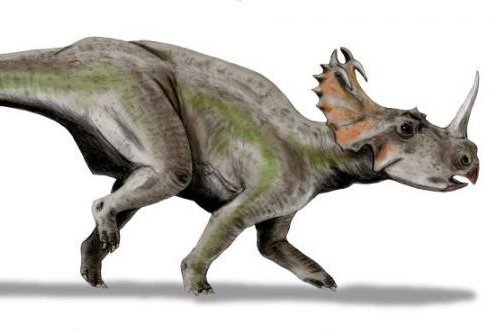1 of 2 | Centrosaurus, the Triceratops relative whose bones contained modern microbes. Photo courtesy of Nobu Tamura
June 18 (UPI) -- When scientists went looking for preserved collagen inside dinosaur bones, they struck out. They did, however, find large colonies of modern bacteria.
"This is breaking new ground -- this is the first time we've discovered this unique microbial community in these fossil bones while they're buried underground," Evan Saitta, a postdoctoral researcher at the Field Museum in Chicago, said in a news release. "And I would say that it's another nail in the coffin in the idea of dinosaur proteins getting preserved intact."
Scientists previously identified well-preserved traces of the protein collagen inside fossilized dinosaur bones, as well as preserved blood and bone cells. The rare findings have spurred interest in the possibility of recovering DNA from preserved dinosaur proteins.
Armed with a pick axe, saw, blowtorch, ethanol and bleach, Saitta headed to Dinosaur Provincial Park in Alberta, Canada, to see if he could identify collagen in dinosaur fossils.
"There's a single layer where there's practically more bone than rock, it's ridiculous how concentrated the bones are," Saitta said. "To collect these bones in a very controlled, sterile way, you need a dig site with a ton of bone because you have to find the bone quickly, expose just enough of one end to know what it is, then aseptically collect the unexposed bit of the bone and surrounding rock all in one."
Saitta carefully recovered the 75-million-year-old bones of a Centrosaurus, a smaller relative of Triceratops. He took the bones back to the lab to analyze their organic makeup.
Researchers compared the fossils' biochemical composition with the makeup of modern chicken bones, sediment samples from the fossil site and ancient shark teeth from a Florida beach.
"We visited multiple labs, and the different techniques gave us consistent and easily interpretable results, suggesting that the aseptic collection was sufficient," Saitta said.
The research, published this week in the journal eLife, proved all the collagen from the dinosaur bones was long gone. However, the analysis revealed the presence of large microbial communities. Lab tests confirmed the anti-contamination techniques used by Saitta worked, suggesting the microbes invaded while the bones were still in the ground.
"We found non-radiocarbon dead organic carbon, recent amino acids, and DNA in the bone -- that's indicative that the bone is hosting a modern microbial community and providing refuge," Saitta said.
Saitta suspects the biofilms created by microbial communities in dinosaur bones may explain the reports of soft tissue found in ancient dinosaur fossils.
Bones contain cavities that attract moisture, as well as phosphorous and iron, all things that microbes need to thrive.
"If you were a bacterium living in the ground, you'd probably want to live in a dinosaur bone," Saitta said. "These bacteria are clearly having a jolly good time in these bones."















